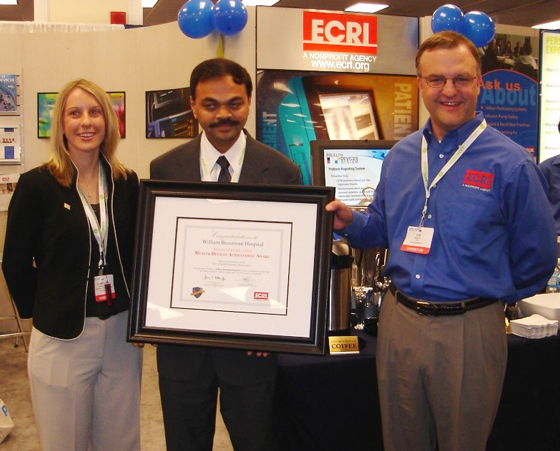Introduction
Beaumont Hospital (Royal Oak, MI) was selected as the winner of the inaugural Health Devices Achievement Award, presented in June 2006 at a reception in Washington, D.C., for its comprehensive approach to selecting and deploying a new communication system to improve telemetry-alarm response times.
The Health Devices Achievement Award recognizes outstanding initiatives undertaken by member healthcare institutions to improve patient safety, reduce costs, or otherwise facilitate better strategic management of health technology.
Learn about the other submissions that achieved recognition.
ECRI congratulates the Beaumont Hospital team: Salil Balar, Kim Bonzheim, Monique Brand, Cathy Campbell, Kim Caramagno, Danielle Diffin, Rani Gebara, Izabella Gieras, Mary Gunn, Sue Hella, Jim Kauflin, Bridget O'Hare, and Rita Stockman. In developing and implementing its initiative, the Beaumont team was also assisted by several physician sponsors and administrators and by a consultant.
Discussion
Despite successful implementation of a new centralized telemetry monitoring system, overall satisfaction with the system at Beaumont Hospital was running low because of shortcomings in the process used to communicate telemetry alarm events. At the time, specially trained telemetry technicians would verify alarms and then page the patient's nurse. The nurse would then call to confirm receipt of the page and to request any additional information. If the nurse did not respond within three minutes, the technician would reissue the page. If necessary, the page would be directed to other personnel following the specified "chain of command." This process was not working well, however. Response times were long. Pages would frequently have to be reissued, which contributed to nurses becoming desensitized to the pages. Teamwork was breaking down. And patient care was being adversely affected.
To investigate the problem, Beaumont staff assembled a multidisciplinary team, including more than a dozen clinical engineers, technicians, nurses, doctors, researchers, and administrators. Using a data-driven, user-centered approach, the team analyzed the problem and evaluated alternatives, including the need for process reengineering and new technology.
|
 Jim Keller, ECRI's Vice President for Health Technology Evaluation and Safety, presents the Health Devices Achievement Award to Salil Balar (center), a Clinical Engineer at Beaumont Hospital, and Izabella Gieras (left), the facility's Director of Technology Management.
Jim Keller, ECRI's Vice President for Health Technology Evaluation and Safety, presents the Health Devices Achievement Award to Salil Balar (center), a Clinical Engineer at Beaumont Hospital, and Izabella Gieras (left), the facility's Director of Technology Management. |
One of the first steps taken was to quantify the problem. To do this, the team chose to measure alarm response time, since this metric is an indicator of the entire technician/nurse communication process. Clinical and human factors engineers measured response times on several occasions. Through these efforts, the facility learned that the existing process resulted in a mean response time of 9.5 minutes.
To help identify possible areas for improvement, the team conducted a failure mode and effects analysis (FMEA). Based on the results of this analysis, the team hypothesized that response times could be reduced to the established target of three minutes by (1) standardizing the technician/nurse alarm communication process and (2) improving the technician's interface with the telemetry monitoring equipment.
Ultimately, it was determined that standardization did not have a significant impact on response times using the existing pager/telephone communication technology. Thus, focus shifted to analyzing the technician/computer interface.
Using videotaped and real-time observations of telemetry technicians and nurses responding to and communicating about alarms, the Beaumont team determined that the pager/telephone method of communication did not meet the needs of the staff. Thus, a decision was made to try a new "communication badge." This badge is a two-way, voice-activated (i.e., hands-free) wireless communication system. Telemetry monitoring technicians can speak directly to the nurses through the badge, and the nurses can speak directly to the technicians to ask questions.
Introducing the new technology significantly streamlined the alarm notification protocol and drastically shortened alarm response times. The Beaumont team reported the following statistics:
Mean alarm response time dropped from 9.5 minutes to 39 seconds, well under the target of 3 minutes.
Use of the communication badge led to 100% closure of the communication loop, compared with an average of 35% when pagers were used.
The team further stated that, as a result of the use of this new technology, staff productivity increased and a renewed sense of teamwork flourished.
The initiative described in this submission is one example of how incorporating human factors testing in the technology management process can lead to optimal technology selection. In addition to advising hospital departments on traditional efficacy and cost considerations, clinical and human factors engineers at Beaumont Hospital work closely with clinicians to conduct human factors and ease-of-use studies, apply risk management techniques, develop process improvements, and integrate technologies to achieve excellence in both technology management and patient care.
ECRI again congratulates the team from Beaumont Hospital for its exceptional efforts in improving patient safety at its facility.